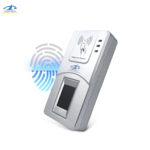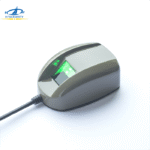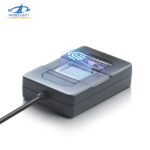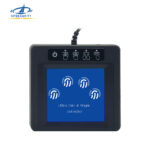What Are Fingerprint Scanners?
Fingerprint scanners are devices used to capture the unique patterns on a person’s fingerprint for identification or authentication. These devices work by scanning the ridges and valleys on the skin’s surface and converting them into a digital template. The core function of any fingerprint scanner is to provide a secure, quick, and accurate method of verifying someone’s identity.
Types of Fingerprint Scanners
Fingerprint scanners are classified into different types based on their scanning technology, such as optical, capacitive, ultrasonic, and radio frequency. Additionally, they can be categorized by the number of fingers scanned (single or multiple) and the intended application, such as security or identification.

1. Optical Fingerprint Scanner
How It Works:
An optical fingerprint scanner uses light to capture an image of the fingerprint. When a finger is placed on the scanner, it illuminates the fingerprint and records an image using a sensor.

Characteristics of Optical Fingerprint Scanners:
Cost-effective: Often less expensive and easier to deploy, making them ideal for entry-level biometric applications.
Clear image capture: Produces clear and detailed fingerprint images, especially in clean environments with minimal interference.
Less effective with dirt or moisture: Performance decreases when scanning wet, dirty, or oily fingers, as these factors can obstruct the light reflection needed for accurate capture.
Sensitive to external light: Performance may be affected by ambient lighting conditions, especially in very bright environments.
Larger form factor: Optical scanners tend to be bulkier compared to other technologies, making them less suitable for compact devices like smartphones.
Durability: Generally less robust against scratches or physical wear on the glass surface, which may impact long-term reliability.
Best Use Cases:
Optical fingerprint scanners are widely used in access control, time attendance systems, and mobile devices. They are ideal for environments where fingers are clean and dry, such as offices and schools. These scanners offer an affordable biometric solution for personal devices, enterprise security, and government applications. However, they may not perform well in industrial or humid environments.
2.Capacitive Fingerprint Scanner
How It Works:

Capacitive fingerprint scanners use an array of tiny capacitors to detect the fingerprint ridges and valleys by measuring the electrical charge. The interaction between the skin and the capacitive sensors creates an image of the fingerprint.
Capacitive fingerprint scanners use an array of tiny capacitors to detect the fingerprint ridges and valleys by measuring the electrical charge. The interaction between the skin and the capacitive sensors creates an image of the fingerprint.
Characteristics of Capacitive Fingerprint Scanners:
High accuracy and security: Capacitive scanners offer high precision and are resistant to fake or spoofed fingerprints, making them ideal for secure applications.
Fast scanning: Provides quick responses with high precision, delivering a smooth user experience in real-time authentication.
Can struggle with very dry skin: Performance can be impacted by extremely dry or cracked skin, as the scanner relies on the conductive properties of the finger’s surface.
Durable and long-lasting: More resistant to wear and tear compared to optical scanners, offering a longer lifespan and consistent performance.
Compact design: Smaller and more easily integrated into mobile devices, laptops, and other compact systems compared to optical scanners.
Resistant to environmental factors: Less affected by ambient lighting or dirt compared to optical scanners, making it more reliable in various conditions.
Best Use Cases:
Capacitive fingerprint scanners are commonly used in smartphones, tablets, and laptops due to their high security and compact size. They’re also widely used in access control systems that require high accuracy.
3. Ultrasonic Fingerprint Scanner
How It Works:
An ultrasonic fingerprint scanner emits high-frequency sound waves that bounce off the fingerprint. These sound waves can penetrate the outer layers of the skin, capturing more detailed data, including the deeper layers of the finger.

Characteristics of Ultrasonic Fingerprint Scanners:
3D image capture: Uses ultrasonic pulses to generate detailed three-dimensional fingerprint images, capturing both surface and sub-surface features.
Works in harsh conditions: Can accurately scan through dirt, oil, moisture, and even certain thin materials, ensuring reliable performance in challenging environments.
Increased security: Higher resistance to spoofing and fake fingerprints due to its ability to read beneath the skin surface.
Consistent performance: Less affected by finger conditions such as dryness, cuts, or surface damage, providing stable recognition.
No need for direct contact: Can function with minimal pressure, reducing sensor wear and improving user comfort.
Ideal for advanced devices: Commonly integrated into high-end smartphones, military-grade equipment, and sensitive authentication systems requiring maximum security.
Best Use Cases:
Ultrasonic fingerprint scanners are ideal for high-security environments such as banking, government applications, and mobile phones with advanced security features. Their ability to capture detailed 3D images and scan through moisture, dirt, and surface damage makes them well-suited for scenarios where reliability and accuracy are critical. These scanners are increasingly used in biometric authentication for secure mobile payments, military systems, law enforcement, and identity verification in border control. Their high resistance to spoofing and environmental interference makes them a preferred choice for institutions that require robust and tamper-proof biometric security.
4. RF (Radio Frequency) Fingerprint Scanner
How It Works:

RF fingerprint scanners use radio frequency signals to capture data beneath the surface of the skin. This technology allows for the detection of the fingerprint’s 3D structure, providing highly detailed information.
Characteristics of RF (Radio Frequency) Fingerprint Scanners
Superior accuracy: Can capture fingerprint data from beneath the surface of the skin, providing highly detailed and reliable biometric information.
Works in challenging environments: Not affected by surface-level issues like dirt, moisture, oil, or minor skin damage, ensuring consistent performance.
Expensive technology: Typically more costly than optical and capacitive scanners due to advanced sensing components and processing capabilities.
High resistance to spoofing: Difficult to deceive with fake fingerprints, as it reads sub-dermal patterns rather than just surface ridges.
Stable over time: Maintains accuracy even as a person’s skin condition changes, making it suitable for long-term use.
Used in high-security sectors: Often found in defense, healthcare, law enforcement, and identity verification systems where maximum reliability is essential.
Best Use Cases:
RF fingerprint scanners are commonly used in law enforcement, high-security environments, and forensic applications due to their advanced accuracy and anti-spoofing features.
Scanning form of fingerprint scanner


1.Single Finger Scanning
2.Multi-Finger Scanning
Single finger scanning involves capturing the fingerprint image of one finger at a time. It is the most common and widely used form of fingerprint identification due to its simplicity, speed, and minimal hardware requirements. This method is particularly suitable for consumer electronics such as smartphones, laptops, and entry-level time attendance or access control systems.
Multi-finger scanning involves capturing multiple fingerprints simultaneously, often in formats like 4-4-2 (four fingers from each hand plus two thumbs). This method is designed for high-security applications that require more detailed biometric data, significantly increasing accuracy and reducing false matches.
Applications of different fingerprint scanners
Choosing the right type of fingerprint scanner depends on the application. Here’s a brief comparison of where each type excels:
1.Optical Fingerprint Scanners
Best for standard applications like time attendance and access control in low-security environments.
Typical Use Cases:
Office and building entry systems
School and campus attendance tracking
Gym membership verification
Library access systems
Hotel room keyless entry
2.Capacitive Fingerprint Scanners
Ideal for mobile devices and access control systems that require high precision and security.
Typical Use Cases:
Smartphones and tablets (e.g., fingerprint unlocking and mobile payment apps)
Laptop fingerprint login (e.g., Windows Hello-enabled devices)
Smart door locks for homes and apartments
Secure workstation login in corporate environments
Payment kiosks and POS terminals requiring user verification
3.Ultrasonic Fingerprint Scanners
Suitable for high-security systems, including financial institutions and mobile phones that prioritize anti-spoofing.
Typical Use Cases:
High-end smartphones with in-display fingerprint sensors (e.g., Samsung Galaxy S series)
Secure mobile banking apps requiring biometric login
Biometric safes and secure vault access
Military-grade access control systems
Identity verification in online financial services and fintech platforms
4.RF (Radio Frequency) Scanners
Perfect for law enforcement, border control, and applications requiring highly detailed and accurate data capture.
Typical Use Cases:
Criminal background checks and forensic identification
National ID enrollment and biometric passports
Voter registration systems in e-governance projects
Immigration control and visa processing centers
Healthcare systems requiring secure patient identity verification
Market Outlook for Fingerprint Scanners
The market for fingerprint scanners is growing rapidly, driven by increased demand for secure authentication solutions across various industries. The rise in mobile phone usage, the adoption of biometrics in financial and government services, and the need for better security in physical and digital spaces are all contributing factors. The market is expected to expand further as innovations in scanner technology, such as ultrasonic and RF scanners, enhance security features and usability.
Related Fingerprint Scanner Products
FAQ
The ultrasonic fingerprint scanner is considered one of the most secure due to its ability to capture 3D details and work in challenging conditions.
While all scanners have some vulnerability, capacitive and RF fingerprint scanners are more resistant to spoofing than optical scanners.
A single-finger scanner is faster and more compact, suitable for personal devices, while a 10-finger scanner provides higher accuracy and is used in law enforcement and large-scale biometric identification systems.
Fingerprint scanners are widely used in smartphones, banking, border control, time attendance systems, and law enforcement.





